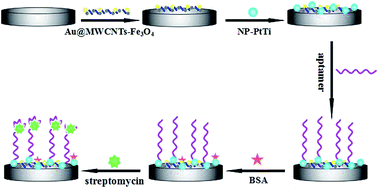A novel electrochemical aptasensor for sensitive detection of streptomycin based on gold nanoparticle-functionalized magnetic multi-walled carbon nanotubes and nanoporous PtTi alloy†
Abstract
A facile electrochemical aptasensor based on a novel signal amplification strategy was employed for sensitive and selective detection of streptomycin for the first time. The aptasensor was prepared by sequentially dripping a gold nanoparticle-functionalized magnetic multi-walled carbon nanotube (Au@MWCNTs–Fe3O4) composite and nanoporous PtTi (NP-PtTi) alloy onto a glassy carbon electrode (GCE) surface. The NP-PtTi alloy with a uniform nanoporous structure was successfully fabricated by selectively de-alloying Al from a PtTiAl alloy in HCl solution. The results demonstrated that the Au@MWCNTs–Fe3O4/NP-PtTi composite not only showed a remarkable synergistic effect towards the aptasensor, but also provided a beneficial immobilization platform for the streptomycin aptamer carrier. Under optimal conditions, a wide linear range from 0.05 to 100 ng mL−1 and a detection limit of 7.8 pg mL−1 were obtained. The designed aptasensor showed an excellent analytical performance with good reproducibility, high selectivity and stability. Finally, the proposed aptasensor was successfully used for the detection of streptomycin in a real sample.


 Please wait while we load your content...
Please wait while we load your content...